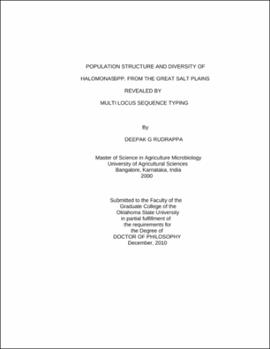| dc.contributor.advisor | Miller, Robert V. | |
| dc.contributor.author | Rudrappa, Deepak G. | |
| dc.date.accessioned | 2013-11-26T08:26:01Z | |
| dc.date.available | 2013-11-26T08:26:01Z | |
| dc.date.issued | 2010-12 | |
| dc.identifier.uri | https://hdl.handle.net/11244/6839 | |
| dc.description.abstract | Scope and Method of Study: The Great Salt Plains (GSP) is an ecologically diverse, hyper-saline environment. Many differences in overall phenotypic characters were observed among Halomonas spp. isolates from the GSP that had >97% 16S rRNA sequence similarity. We believe these Halomonas spp. isolates have evolved over a long period of time by means of developing certain genetic mechanisms. Multi Locus Sequence Typing (MLST) was used to study the population structure of these isolates. Housekeeping genes ectB, gyrB, and recA along with 16S rRNA and the ITS region were assayed in 32 Halomonas spp. isolates. MLST analysis identified 28 unique sequence types indicating a high level of genetic diversity. Among the house keeping genes, recA demonstrated increased resolution indicating that Halomonas spp. isolates contain several genetically distinct phylotypes most likely due to environmental bottlenecks and recombination events. We found evidence for frequent LGT and recombination among these isolates. | |
| dc.description.abstract | Findings and Conclusions: MLST analysis identified 28 unique sequence types indicating a high level of genetic diversity. Among the house keeping genes, recA demonstrated increased resolution indicating that Halomonas spp. isolates contain several genetically distinct phylotypes most likely due to environmental bottlenecks and recombination events. We found evidence for frequent LGT and recombination among these isolates. Recombination rates were on par with other sexual bacteria. The rates of recombination observed are high enough to overcome the effects of population bottlenecks and periodic selection that would otherwise purge the genetic variation generated. These results support the hypothesis that a high level of speciation has occurred among Halomonas spp. isolates at the GSP site even though 16S rRNA sequence similarity has been conserved. Phylogenetic relationship of very closely related Halomonas spp. isolates was resolved by MLST. The results of this study have opened new roads for the research topics that range from the molecular evolution of environmental isolates to the significance of recombination in evolution of bacteria. | |
| dc.format | application/pdf | |
| dc.language | en_US | |
| dc.rights | Copyright is held by the author who has granted the Oklahoma State University Library the non-exclusive right to share this material in its institutional repository. Contact Digital Library Services at lib-dls@okstate.edu or 405-744-9161 for the permission policy on the use, reproduction or distribution of this material. | |
| dc.title | Population structure and diversity of Halomonas spp. from the Great Salt Plains revealed by multi locus sequence typing | |
| dc.contributor.committeeMember | Burnap, Robert Lord | |
| dc.contributor.committeeMember | Bender, Carol L. | |
| dc.contributor.committeeMember | Elshahed, Mostafa S. | |
| osu.filename | Rudrappa_okstate_0664D_11230.pdf | |
| osu.accesstype | Open Access | |
| dc.type.genre | Dissertation | |
| dc.type.material | Text | |
| dc.subject.keywords | great salt plains | |
| dc.subject.keywords | halomonas | |
| dc.subject.keywords | multi locus sequence typing | |
| dc.subject.keywords | recombination | |
| thesis.degree.discipline | Microbiology and Molecular Genetics | |
| thesis.degree.grantor | Oklahoma State University | |
